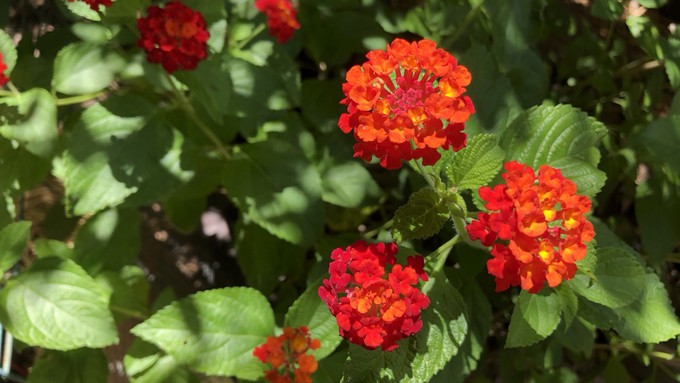
First revisions since 2012 reflect rising low temperatures; Sacramento stays in same zone

Colorful lantana, a popular perennial shrub, is more likely to survive Sacramento winters than it would have 20 years ago. Kathy Morrison
What we plant and when are changing. Why? Winter overnight lows aren’t getting as cold as they used to get. The first frost is arriving later.
Both changes affect what we grow. We may not have enough cold to grow certain varieties of peaches and pears, but limes and lantana are a lot more comfortable. These warming shifts didn’t happen quickly, but gradually over years.
With that in mind, the U.S. Department of Agriculture decided it was time to tweak its hardiness zone maps again. The last revision was 2012.
“Overall, the 2023 map is about 2.5 degrees warmer than the 2012 map across the conterminous United States, (the lower 48 states and District of Columbia),” Christopher Daly, director of the PRISM Climate Group and the map's lead author, told reporters this week. “This translated into about half of the country shifting to a warmer 5-degree half zone, and half remaining in the same half zone. The central plains and Midwest generally warmed the most, with the southwestern U.S. warming very little.”
On this latest map, Sacramento stayed in the same zone: 9b. It moved into that zone from 9a in 2012. That’s out of 13 total zones (zone 1 being the coldest), each representing a 10-degree shift in low temperatures. Each zone is divided into A and B half zones, determined by 5-degree increments.
In zone 9b, our extreme low winter temperature is expected to be between 25 and 30 degrees. (Zone 9a gets down to 20 to 25 degrees.)
Sacramento gardeners know this anecdotally. Lantana, for example, has become a local bellwether for winter cold. A magnet for butterflies, this popular low-water perennial shrub can take a light frost, but temperatures under 28 degrees can kill it. In decades past, lantana rarely made it through the winter. Now, most lantana plants survive many years with no problems.
According to the USDA, the hardiness zone map is based on the extreme lowest temperature a region historically averages in winter. It’s not a prediction, but a reflection of past winters – specifically 1991 to 2020. It also doesn’t differentiate from spending 30 nights at 28 degrees or just one night at that temperature. And the zones don’t reflect extremes in daytime temperatures, just the overnight lows.
Why focus on lows? Because cold kills – especially perennials, shrubs and trees. Cold and chill hours (time spent under 45 degrees) also determines whether many plants flower and set fruit.
The USDA tends to tailor its hardiness zones to perennials and fruit.
“All Plant Hardiness Zone Maps (PHZM) should serve as general guides for growing perennial plants,” says the new guidelines. “They are based on the average lowest temperatures, not the lowest ever. Zones in this edition of the USDA PHZM are based on 1991-2020 weather data. This does not represent the coldest it has ever been or ever will be in an area, but it simply is the average lowest winter temperatures for a given location for this 30-year span (1991-2020).”
The USDA adds a caveat to its map drawing: Historic lows can happen any winter.
“Consequently, growing plants at the extreme range of the coldest zone where they are adapted means that they could experience a year with a rare, extreme cold snap that lasts just a day or two, and plants that have thrived happily for several years could be lost,” warns the USDA. “Gardeners need to keep that in mind and understand that past weather records cannot provide a guaranteed forecast for future variations in weather. They should consult with other knowledgeable producers and gardeners e.g., established nurseries or Master Gardeners or extension services with extensive expertise with conditions at their locales.”
The USDA rarely revises its hardiness zone maps. Before 2012, the USDA hardiness zone map was last revised in 1990 as part of a joint project between the USDA and the U.S. National Arboretum, using data from 14,500 weather stations across the country.
The new map pulls data from even more weather stations and other sources. It’s also offered online as an interactive resource. Just plug in your zip code.
Find it here: https://planthardiness.ars.usda.gov/.
Comments
0 comments have been posted.Sacramento Digs Gardening to your inbox.
Sites We Like
Garden Checklist for week of July 21
Your garden needs you!
* Keep your vegetable garden watered, mulched and weeded. Water before 8 a.m. to reduce the chance of fungal infection and to conserve moisture.
* Feed vegetable plants bone meal, rock phosphate or other fertilizers high in phosphate to stimulate more blooms and fruiting. (But wait until daily high temperatures drop out of the 100s.)
* Don’t let tomatoes wilt or dry out completely. Give tomatoes a deep watering two to three times a week.
* Harvest vegetables promptly to encourage plants to produce more. Squash especially tends to grow rapidly in hot weather. Keep an eye on zucchini.
* Pinch back chrysanthemums for bushy plants and more flowers in September.
* Remove spent flowers from roses, daylilies and other bloomers as they finish flowering.
* Pinch off blooms from basil so the plant will grow more leaves.
* Cut back lavender after flowering to promote a second bloom.
* It's not too late to add a splash of color. Plant petunias, snapdragons, zinnias and marigolds.
* From seed, plant corn, pumpkins, radishes, winter squash and sunflowers.